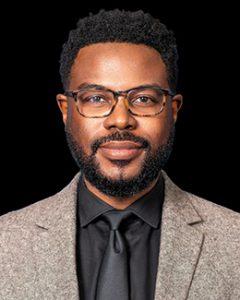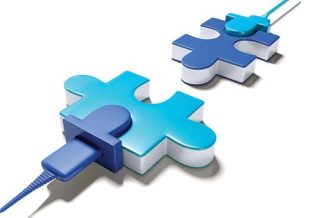FOCUS
5 ways coaches can support technology integration
By D'Andre Weaver and Kasha Hayes
Categories: Coaching, Personalization, TechnologyApril 2024
Like most tools, educational technology is only successful when people know how to use it well. Yet in a survey of schools across the U.S., half reported that the steep learning curve for teachers’ use of technology is a moderate or large challenge (Gray & Lewis, 2021). Providing the right support on technology integration to educators is therefore critical to make the most of technology resources, including artificial intelligence, in schools.
At the Verizon Innovative Learning Schools program, we’ve learned over the last decade how to best prepare teachers to embrace and integrate technology, and it all comes back to human-centered professional learning. No matter how advanced AI becomes, nothing can replace person-to-person connections, especially in teaching and learning interactions. That’s why we believe in the power of having dedicated, experienced coaches work with educators to build their capacity to use technology efficiently and effectively.
🚀 Empowering educators to embrace technology goes beyond devices—it's about personalized support and collaborative learning. #TeacherTwitter #TheLearningPro Share on X
Verizon Innovative Learning Schools coaches are school-based coaches selected by the participating school or district. While most coaches work in one school, some coaches work in a shared model and split their time between campuses. Often, the coaches are teachers who have already shown leadership in technology or professional learning at their school.
Verizon Innovative Learning Schools coaches support teachers using various coaching models and stances, work within professional learning communities and during common planning time, and help develop the capacity of teacher leaders.
The program is based on the philosophy that a great coach doesn’t tell a teacher how to implement technology in the classroom. Rather, the coach serves as a thought partner and information source to empower teachers to own their professional learning and sustainably change how they think about and approach technology in their classrooms.
Coaching techniques and focus are generally based on the needs of the teacher and the goals of the school and district. Depending on the coaching model at the school, some coaches may support teachers by request, while others may work to support all teachers in specific content areas or grade levels.
Districts and schools are encouraged to think about and systematize the support that Verizon Innovative Learning Schools coaches provide with a focus on creating sustainable practices that can be used for years to come.
A key component of the program is that coaches engage in their own professional learning about how to support their peers and in networking opportunities to learn from each other. Over the past 10 years, our team at Digital Promise has focused our work with coaches on professional learning and personalized coaching support, which they then implement in their buildings.
We’ve gathered many lessons, including the broad applicability of these practices to coaching beyond technology-focused support. These concepts can be applied by any coach because they focus on leveraging human connections, building on educators’ existing strengths, and viewing teachers as learners.
We have found five ways coaches can support teachers with using technology in the classroom and overall instructional improvement:
- Provide individualized, targeted support to teachers;
- Create opportunities for teacher collaboration;
- Model best practices for using technology in the classroom;
- Address educators’ concerns about new technology, including the use of AI in school; and
- Strengthen alignment between district technology policies and classroom practice.
🤝 Coaches play a critical role in helping teachers 🌐 navigate the complexities of #edtech, including AI. It's human-centered professional learning that empowers educators to integrate technology. #TheLearningPro Share on X
Provide individualized, targeted support to teachers.
To meet teachers where they are, coaches begin by understanding each teacher’s comfort with devices and tech tools, including AI technologies. This understanding is the foundation for ongoing, individualized support and provides a sense of what the teacher is willing to try. Coaches ask teachers questions like:
- What has your experience been with technology?
- Why is technology important and useful for your teaching?
- Which digital tools have you tried?
- Which digital tools are you interested in learning more about?
From there, coaches help teachers set a vision for technology in their classroom that is aligned to their school or district vision and grounded in learning goals for students. Establishing this vision helps the teacher and coach get on the same page about what the teacher wants in their classroom and how technology can help achieve learning outcomes.
Questions to refine the vision might include: If you implemented AI or another form of technology in your classroom, and everything was going well, what would it look like and sound like? What would the teacher be doing, and what would students be doing?
Once the vision is clear, the coach works with the teacher to turn that vision into a collaborative coaching work plan. A simple starting place for this can be the coach asking the teacher, “What is the first step you would take to realize the vision you described?” If the teacher doesn’t know, the coach offers to brainstorm ideas together.
Throughout the course of the coaching relationship, coaches also consider how to help teachers sustain the changes they have decided to implement. By co-developing work plans that include regular feedback loops, teachers and coaches can check in regularly and adjust as needed. A great way to establish this is for the coach to ask the teacher, “How do you want to receive feedback?”
Research about coaching grounded in positive psychology tells us that the most effective coaches work to uncover existing strengths that can be built on (Kauffman, 2006). Coaches can use this approach when helping teachers think about what digital tools or technologies they want to try.
A good way to begin is to ask, “What do you believe are your strengths?” If a teacher says that they are creative, for example, a coach may follow up by asking if the teacher would like to learn more about technology tools that foster creativity and content creation. This approach can help the teacher connect new learning to an existing strength.
Good coaches also remember to celebrate accomplishments along the way. No achievement is too small to celebrate. By doing this, coaches help create the kind of environment that gets teachers excited to try using technology, take risks, build agency, and engage in their own professional learning.
Create opportunities for teacher collaboration.
Teaching can often feel like a solitary job. Technology can play a role in mitigating that isolation, and coaches can help facilitate it.
First, coaches can help teachers use technology tools to collaborate more effectively and efficiently. For example, educators often gather to review student work and analyze student data. Coaches can help teachers use technology to make this more efficient and effective. AI can help teachers identify approaches and best practices to test to accelerate student learning or improve outcomes, then teachers and coaches can come together to evaluate the effectiveness of those best practices.
Secondly, coaches can help teachers learn from each other about how to use technology in meaningful ways. With many teachers facing similar challenges about using new technology tools, what better source of information than their own peers? These three examples from Verizon Innovative Learning coaches demonstrate how to facilitate this kind of collaboration among teachers.
- One coach in a middle school encourages collaboration through the use of “pineapple charts” (Cargal, 2021), which draw on the pineapple as a traditional symbol of hospitality. When teachers place the pineapple chart outside their classroom doors, they are indicating their rooms are open to visits from their fellow teachers to observe how they use technology in their classroom. After these visits, the coach debriefs with teachers about what they observed, helps them identify best practices, and talks through how they might implement new ideas inspired by their visits.
- Some of our coaches create collaborative learning groups called teacher leader corps. Teachers who participate in these groups observe one another’s classrooms, lead professional learning sessions, and tackle shared challenges. In one group, a coach invited a teacher to serve as the school’s Google Forms expert. Teachers visit this leader’s classroom to see students leveraging Google Forms in a variety of ways and support each other in creating their own Google Forms.
- One coach in a middle school created weekly videos of tech tips. In these short videos, she highlights one or two technology tools teachers can try. The coach also provides individual support on any of the tools she features in her videos and has open office hours where teachers can experiment with AI and other tools in a low-stakes, fun environment.
Model best practices for using technology in the classroom.
Modeling a technology tool, practice, or approach can be a great way for coaches to introduce teachers to new technology applications or help them overcome anxiety about using those approaches. But good coaches never force modeling as a coaching technique, especially if the teacher is not open to learning from it. Like other strategies, it’s important to identify why modeling is being used, what the intended outcome will be, and whether it is the right fit for the situation.
If a teacher is open to the coach engaging in modeling a technology tool in the classroom, the coach should begin by asking questions like:
- What do you hope to get out of observing me model this tool?
- When I use this tool, is there something specific you would like me to demonstrate?
- How can modeling this tool help us reach our shared coaching goals?
- How do you want to capture your thinking and observations while I model this tool?
Following the modeling, the coach and teacher evaluate together whether the approach to using technology did or did not work. Then they debrief the overall lesson and discuss takeaways.
Some coaches may worry about modeling if they are not content experts in the subject area the students are learning. However, there are still ways they can incorporate modeling into their coaching practice. For example, the teacher can remain the leader of the lesson and content, while the coach offers a brief model of the technology tool during instruction.
If modeling is not the right fit, there are other ways for coaches to help teachers understand and apply specific tools or instructional approaches. The coach and teacher can co-teach a lesson that includes technology tools, co-plan an upcoming lesson that integrates technology, or review student work together to decide on next steps for using technology to meet students’ needs.
Address educators’ concerns about new technology, including the use of AI in school.
Teachers are not just teachers; they are also learners (Knowles et al., 2015). Adult learners need specific kinds of environments in which they feel safe to learn, take risks, make mistakes, and grow, including when they are integrating AI in school — for example, through ChatGPT. Here are some ways coaches can help create those kinds of environments and address teachers’ concerns and possible resistance.
Start with the “compelling why.” Change can feel ambiguous, unrelatable, irrelevant, or impossible to do. When coaches clarify the “why” behind the change and how it will impact their students, it can reduce teachers’ anxieties and resistance.
Find out what teachers want to learn and try. Starting with the technologies teachers are curious about can help build teachers’ intrinsic motivation, encourage them to take risks, and open the door to additional possibilities.
Help identify tools that are immediately applicable. Teachers may respond better to technology when they see an immediate use for it in their classroom and see how it can help students learn. Coaches can share or brainstorm those opportunities, including how to integrate a new tool into one small part of a lesson, such as using AI-generated writing prompts, so that teachers learn technology doesn’t have to be a massive shift.
Identify opportunities to automate tasks using technology. Technology tools can also free up teachers’ time from administrative tasks and time-consuming projects so they can focus on interactions with students and other teaching tasks that have a direct impact on student learning. Coaches can ask teachers about tasks that might be automated through the use of AI or other tools so they can focus more time and energy on their students.
Coaches play a key role in building environments that are safe for taking risks and getting feedback, but administrators also have a role to play in building that culture and encouraging a growth mindset. Administrators should be thoughtful and intentional about this role — for example, deciding not to conduct teacher observations when a new technology tool is being piloted.
Strengthen alignment between district technology policies and classroom practice.
Some districts may have a preapproved list of digital apps and tools that are permissible for teachers to use. Coaches play a role in helping teachers understand why it’s important to use the district-approved tools — for example, to ensure the tools have adequate protections for student data privacy.
Coaches aren’t meant to be a single, magic solution to technology challenges, such as the complicated issue of using AI in school. They should be part of a system of support. It’s also important to remember that the coaches themselves need support and preparation from school and district leaders.
But we have found that they are a key part of our professional learning approach to helping teachers expand and grow how they think about technology use in the classroom. For example, 82% of participating Verizon Innovative Learning Schools teachers have reported that the program helped them explore new ways of teaching.
Inspiration and support
All kinds of coaches and professional learning facilitators — even those whose jobs don’t explicitly include technology — can use the concepts and strategies described here. They can bring a human face and an individualized approach to helping educators use available technology tools. They can be an inspiration and support for instructional risk-taking and innovation that can help improve teaching and prepare students for the future. With a coaching system in place, technology use can be purposefully woven into professional learning and strategic plans to meet all teachers where they are and move them forward in affirming ways that contribute to student success.
Download the PDF here.
References
Cargal, A. (2021, June 10). Opening the door to professional learning. Edutopia. www.edutopia.org/article/opening-door-professional-learning/
Gray, L. & Lewis, L. (2021). Use of educational technology for instruction in public schools: 2019-20. National Center for Education Statistics. nces.ed.gov/pubs2021/2021017.pdf
Kauffman, C. (2006). Positive psychology: The science at the heart of coaching. In D.R. Stober & A.M. Grant (Eds.), Evidence based coaching handbook: Putting best practices to work for your clients (pp. 219-253). John Wiley & Sons.
Knowles, M.S., Holton III, E.F., & Swanson, R.A. (2015). The adult learner: The definitive classic in adult education and human resource development (8th ed.). Routledge.
Categories: Coaching, Personalization, Technology
Recent Issues
WHERE TECHNOLOGY CAN TAKE US
April 2024
Technology is both a topic and a tool for professional learning. This...
EVALUATING PROFESSIONAL LEARNING
February 2024
How do you know your professional learning is working? This issue digs...
TAKING THE NEXT STEP
December 2023
Professional learning can open up new roles and challenges and help...
REACHING ALL LEARNERS
October 2023
Both special education and general education teachers need support to help...












